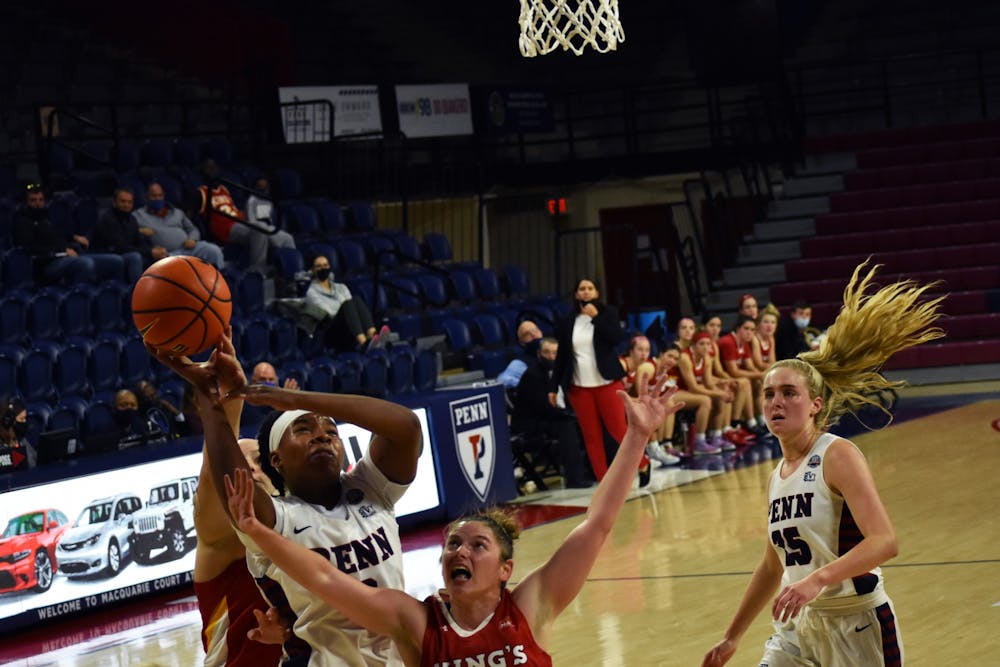
Penn women’s basketball match against the King’s College Monarchs was a tale of two entirely different offenses.
It was a must-win game for the Quakers — not because of any abnormal impact on their season, but because of the fact that they were facing a Division III team. As junior guard Kayla Padilla, arguably their best player, was sitting on the bench, Penn had to prove that they could make the necessary adjustments in order to avoid a loss that would, quite frankly, be embarrassing.
With a 91-55 final score over King’s College, led by 29 points from sophomore forward Jordan Obi, Penn did so in convincing fashion.
King’s College's early offensive approach was to throw up as many three-pointers as possible. In the vein of how detractors most pessimistically stereotype the modern-day NBA, King's College seemed to be operating from the advanced analytical realization that shooting 33.3% from the three-point line would generate the same amount of points as shooting 50.0% on two-pointers.
In the first half, as Penn primarily ran a zone defense, the team was unable to mitigate the barrage from the Monarchs, ceding nine three-pointers on 20 attempts.
Even so, the Quakers were more than able to make up the gap through their overwhelming presence in the paint on both ends. While the team got off to a slow scoring start, Obi’s impact was immediately felt as she notched two steals within the first two minutes of the game.
Much of the offense was built from the defense. The Monarchs were often literally outsized by Penn in the paint, as Penn forced turnovers off of blocks and steals, and subsequently converted many of their points on fast breaks and easy layups.
The Quakers didn’t often command possession for prolonged periods of time, because they didn’t need to. By locking up the opposing team inside the three-point line — the Monarchs were a collective 7-for-25 from inside the arc — they were more than able to make up the deficit.
“That’s one of our principles that we always live on. We let our defense create our offense,” junior guard Sydnei Caldwell said. “Just intensity, [aggression], switching … it gets us easy buckets.”
And the easy buckets came. Penn’s strength in the paint drew fouls from the Monarchs, and the Quakers capitalized, going a collective 13-for-16 from the free throw line.
Once Penn made halftime adjustments to more man-on-man defense, a win was almost guaranteed. The Monarchs made only three three-pointers and scored only 20 points in the entire second half, while Penn tacked on 43 more points.
Perhaps most importantly for the team's future, the lead allowed for the Quakers to give less-experienced players an opportunity off the bench. Freshman Lizzy Groetsch and junior Silke Milliman both played over 20 minutes, while Caldwell, a transfer from Arizona State, started the game and had a greater opportunity to adjust to a new system.
There are reasons for skepticism — it’s not a reach to be concerned about how the paint-heavy style that Penn flashed might fare against teams that are more their size, speed and caliber and, as such, won’t be as easily out-matched or forced to resort to fouls. Similarly, the shots given up in the first half may have hurt even more against a Division I team.
But it would be absolutely unfair to look at this win and be pessimistic. Again, the Quakers were running without one of their star players, Padilla, and their defense on the perimeter sharply improved in the second half. The team did what it had to do: get a convincing win against a worse opponent and set itself up well for tougher match-ups down the line.
A game against a Division III opponent is far from season-defining, but it offers up a hint of what we might expect in the future. If this is the offense that Penn can execute throughout the season — high-paced and intense — they will, at the very least, be exciting to watch.
KATHRYN XU is a College junior from New Providence, N.J. studying Physics and English. She can be reached at dpsports@thedp.com.
The Daily Pennsylvanian is an independent, student-run newspaper. Please consider making a donation to support the coverage that shapes the University. Your generosity ensures a future of strong journalism at Penn.
Donate




